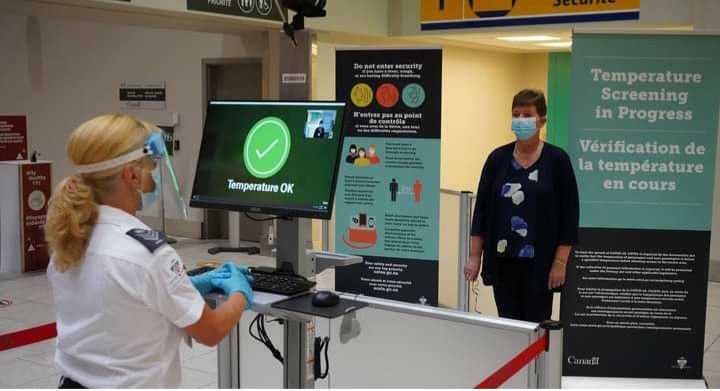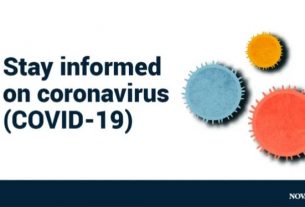**** Canadian Air Transport Security Authority Release
Health and safety will always be our top priority. This Wednesday, Sept. 23, the Canadian Air Transport Security Authority will implement mandatory temperature screening for all passengers and staff entering the secure area of the airport.
Measures taken in response to COVID-19
Over the last few months, the airport environment has experienced rapid change in tandem with the rest of the world in relation to COVID-19. CATSA is closely monitoring the situation to ensure we continue to deliver our mandate.
Within this evolving environment, CATSA’s priority remains the well-being of the screening officers and of those travelling through and working in Canadian airports. To that end, we have made several changes:
- If you exhibit known COVID-19 symptoms such as a cough or difficulty breathing, you will be required to leave the checkpoint and return to the public area.
- Starting at the entrance to the checkpoint and throughout the screening process, we ask that you allow two metres between yourself and other passengers.
- Temperature screening is being phased in at Canada’s 15 busiest airports. You will not be permitted to proceed to the screening checkpoint if your temperature, after two separate tests, is at or above 38 degrees – the threshold set by Transport Canada.
- You are asked to hold on to your own electronic or printed documents (boarding pass, Nexus card) while they are scanned.
- You can also carry one bottle of hand sanitizer up to 355 ml in addition to the 100 ml bottles to be placed in the 1 L clear resealable bag.
- At major airports, additional hand sanitizing units have been placed by the checkpoints to be used by the screening officers and the public.
- Screening officers now wear gloves at all positions and a face mask while working in positions where physical distancing is not possible and when required to conduct close-contact screening. They will add a face shield if the individual being screened cannot wear a face covering.
- Screening officers now change explosive trace detection swabs after each use.
- We have increased the bin-cleaning frequency and are using strong anti-viral cleaning products for bins and other surfaces around the checkpoint.
Face coverings – you must bring and wear one
All passengers must bring a face covering before entering the screening checkpoint. Acceptable face coverings are those that cover the mouth and nose, are made of at least two layers of tightly woven fabric (such as cotton or linen), and are properly secured to the head. Militaristic masks such as gas masks or face coverings that cover the entire face are not considered acceptable face coverings. See the Public Health Agency of Canada’s guidelines on face coverings, including instructions on how to make your own.
If you cannot wear a face covering for medical or health reasons, you must provide a medical certificate signed by a medical professional confirming that you are unable to wear a face covering. The signed medical certificate is required in order for a passenger to be permitted to board their flight. Children under two years of age are not required to wear a face covering.
Note that wearing a face covering does not replace the need to practice proper coughing and sneezing etiquette and physical distancing of at least two metres.
Temperature screening
Temperature screening is being implemented in phases at Canada’s 15 busiest airports, starting July 30 at Vancouver, Calgary, Toronto-Pearson and Montreal-Trudeau. On or before September 30, 2020, temperature screening operations will commence at the next 11 busiest airports (St. John’s, Halifax, Québec City, Ottawa, Toronto-Billy Bishop, Winnipeg, Regina, Saskatoon, Edmonton, Kelowna and Victoria).
All passengers departing from these airports will be required to undergo temperature screening before proceeding to the screening checkpoint. They will have their temperature taken by either a temperature scanning camera on a stand that is stationed at a distance of two metres, or at a closer distance by a contactless, hand-held thermometer. Glasses must be removed before a temperature reading can be taken by the camera, and persons wearing headwear may have to temporarily adjust it to have their temperature measured (private screening will be available on request near the temperature screening area for those who wish to make adjustments in private).
Passengers with temperatures below 38 ⁰C, the threshold set by Transport Canada, will be able to proceed to the checkpoint. Those with temperatures at or above 38 ⁰C on the first screening will be asked to wait for 10 minutes in a nearby designated waiting area, unless they present a medical certificate specifically indicating that their elevated temperature is not due to COVID-19 (a negative COVID-19 test is not sufficient). If a second reading shows a temperature below 38 ⁰C the passenger may proceed; if the temperature remains at or above the threshold, or if the passenger refuses a second reading, they will not be permitted to enter the screening checkpoint, and they will be provided with further instructions. As per Transport Canada’s directive, the passenger will not be permitted to enter a restricted area at any airport in Canada for a period of 14 days after the day of the elevated reading, unless they provide a medical certificate certifying that their elevated temperature is not related to COVID-19. Passengers are not permitted to undergo a third temperature check.
For those with an elevated temperature, your temperature reading will not be recorded and any information that is collected will be protected under the Privacy Act and other applicable legislation (see CATSA’s privacy policy for more information).
Keeping a safe distance
CATSA has made several changes to ensure physical distancing is maintained between screening officers and those going through the security checkpoint whenever possible. Screening officers will also remind all passengers to wear face coverings and maintain the recommended two-metre distance from each other while at the checkpoint. The screening officers themselves will also wear face coverings if required to conduct close-contact screening and will add a face shield if the individual being screened cannot wear a face covering.
Passengers are asked to hold their own documents for scanning (e.g., boarding passes or NEXUS cards). If an alarm needs to be resolved during screening, passengers will be asked to re-divest their items as a first option to reduce the need for a physical search.
In some airports, CATSA has also placed markers on the ground to remind those waiting at the security checkpoint to respect the recommended two-metre distance whenever possible. We have made other physical adjustments, including the installation of instructional signage, leaving alternate lines closed at pre-board screening where possible and operating only two of four divest stations on CATSA Plus lines. At bag search stations, an additional table offers extra distance between the search officer and passenger.
While it is not always feasible to avoid contact during screening, these measures serve to minimize it as much as possible. It is also important to note that the screening process is transitory in nature and most interactions are brief, which public-health experts have explained is a significant factor in reducing the risk of transmission.
A common goal
Aviation is an essential service, ensuring people and goods get to where they need to go, and CATSA has taken every step possible to ensure this happens safely. The success of these efforts also depends upon the cooperation of passengers to wear face coverings, maintain physical distancing whenever possible and complete their screening in a timely and safe manner – listening for instructions and cooperating with extra measures where necessary. CATSA’s goal is to ensure that everyone working in and travelling through airports does so as safely and securely as possible at this challenging time.
For the latest information on COVID-19, go to canada.ca/coronavirus.




